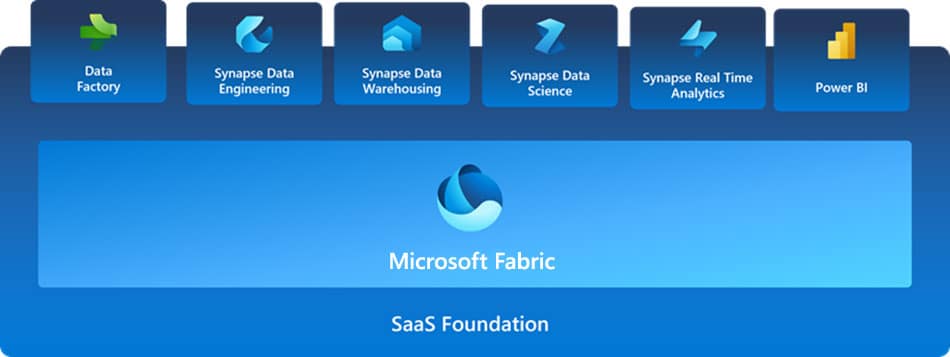Microsoft Fabric: A Versatile Entry Point for Your Data and Analytics Initiatives
Looking to meet your data and analytics initiatives but don't know where to start? Velosio is here to help.

Trey Johnson
Data Analytics Solution SpecialistTable of Content
Data has become an important cornerstone of business strategy and operations. The journey of data within an organization is a critical pathway that transforms raw data into actionable insights, driving informed decision-making and strategic initiatives. Many organizations struggle with data analytics when it’s one person trying to crunch numbers in Excel in addition to their day job or when Enterprise Resource Planning (ERP) or Customer Relationship Management (CRM) data needs to be bridged from legacy solutions to new ones, or you need to augment your data to gain insight from it.
The inception of the data journey begins with defining and collecting data and figuring out what happened and why. Businesses must identify the types of data that align with their strategic goals and operational needs. This stage involves meticulous planning to ensure the data collected is relevant, accurate, and legally compliant. Establishing robust data governance frameworks at this stage is crucial to setting the standards and protocols for data management throughout its lifecycle.
Once data is collected, the next step is processing and cleaning. This stage is about refining the data, removing inaccuracies, and standardizing formats to prepare it for analysis. Employing DataOps practices can streamline this process, leveraging automation and continuous integration to enhance efficiency and reliability.
For modeling and analyzing processed data, businesses apply statistical models, machine learning algorithms, and other analytical methods to extract meaningful patterns and insights. This stage is pivotal as it translates data into a form that can inform business decisions and strategies.
Visualization tools and techniques are used to present data in an accessible and comprehensible format, enabling stakeholders to grasp complex information quickly. Effective data visualization facilitates evidence-based decision-making and can significantly impact the strategic direction of a business.
Microsoft Fabric is a comprehensive data platform designed to streamline and enhance a company’s data journey in the age of AI. It integrates technologies that you may already be utilizing at your organization – Azure Data Factory, Azure Synapse Analytics, and Power BI into a unified product, allowing data and business professionals to fully harness their data’s potential. This integration simplifies the analytics system, which is often a complex maze of disconnected services, by providing a single, cohesive experience. With Microsoft Fabric, organizations can manage their data with greater efficiency, from ingestion and transformation to visualization and analysis, laying a solid foundation for AI-driven insights and decision-making. Additionally, Microsoft Fabric fosters collaboration among different roles within an organization, offering a secure and governed Software-as-a-Service (SaaS) experience that is ready to address the multifaceted challenges of today’s data landscapes.

Microsoft has introduced a groundbreaking platform: OneLake, which serves as the foundation of Microsoft Fabric, and is essentially the evolution of the Data Lake. This innovative solution is poised to revolutionize the way organizations handle their data, offering a unified, logical data lake that comes automatically with every Microsoft Fabric tenant.
Similarly to OneDrive, OneLake is designed to simplify the complex data ecosystems that businesses manage daily. It eliminates the need for multiple data lakes, reducing the overhead associated with managing various resources. With OneLake, organizations have a single copy of data that can be used across multiple analytical engines, fostering collaboration and improving efficiency.
The platform is built on Azure Data Lake Storage (ADLS) Gen2, supporting any file type, structured or unstructured, and ensuring compatibility with existing ADLS Gen2 applications, including Azure Databricks. This open architecture allows for seamless integration and flexibility, catering to the diverse needs of data engineers and developers alike.
OneLake’s governance model is another standout feature. Governed by default with distributed ownership, it empowers different parts of an organization to manage and access policies without a central gatekeeper. This approach aligns with the concept of a tenant in a SaaS service, providing a natural governance and compliance boundary under the control of a tenant admin.
The platform’s integration with Microsoft Fabric ensures that every tenant automatically provisions OneLake, with no extra resources to set up or manage. This integration signifies a step towards a more streamlined, efficient, and collaborative data management environment.
For organizations embarking on their data journey, OneLake offers a starting point that promises ease of use, governance, and integration. It’s a testament to Microsoft’s commitment to innovation in data management, providing a foundation for analytics that can scale with the growing demands of businesses.
What sets Microsoft Fabric apart is its ability to provide a complete analytics solution within a single platform. Traditionally, organizations have had to navigate a complex maze of specialized services, often resulting in fragmented systems that are difficult to manage and integrate. Microsoft Fabric addresses this challenge by offering a unified experience that simplifies the analytics process, from data integration to business intelligence.
The integration of AI within Microsoft Fabric is particularly noteworthy. With the inclusion of AI-driven analytics and visualization tools, the platform empowers business analysts and professionals to extract meaningful insights from their data. The AI capabilities of Microsoft Fabric are not just add-ons; they are seamlessly woven into the platform, ensuring that users can leverage the full potential of AI without the need for complex integrations.
Moreover, Microsoft Fabric’s deep integration with Microsoft 365 enhances the user experience by providing insights within the familiar workspace of business users. This integration ensures that the transition to data-driven decision-making is as smooth as possible, enabling organizations to harness the power of their data effectively.
As we look to the future, the role of AI in data analytics will only become more significant. Platforms like Microsoft Fabric are leading the charge by providing the tools necessary for organizations to stay ahead in the era of AI. With its comprehensive approach to analytics and built-in AI capabilities, Microsoft Fabric is poised to be a key player in the transformation of data management and analysis.
Microsoft Fabric is a robust platform that has been instrumental in helping businesses transform their data into actionable insights.
Microsoft Fabric has caught the imagination of many customers, partners, and community members. Since the preview announcement, 25,000 organizations around the world are already using Fabric today, including 67 percent of the Fortune 500. Most customers appreciate Fabric’s end-to-end value proposition, with 84 percent of companies using three or more workloads.
Many Velosio customers begin with data from their ERP or CRM systems such as Microsoft Dynamics 365 Business Central, then combine that data with other sources such as on-premises solutions, cloud data, SaaS data, streaming data, and more. This gives them a single version of the truth of organizational data for better decision-making.
“In developing and launching EY Intelligence, Microsoft Fabric has been a game changer. Our unique analytics as a service offering gives the C-suite at our client organizations cross functional transparency and on demand insights to make better and quicker decisions,”
—Swen Gehring, Director, Strategy and Transactions, Ernst and Young.
One of the most compelling use cases for Microsoft Fabric is in predictive analytics. For instance, the platform offers end-to-end AI samples, such as predicting customer churn. Using Microsoft Fabric, you can build a model to forecast the rate at which customers might stop doing business with you, showcasing Microsoft Fabric’s potential to extract valuable insights from data.
Microsoft’s ecosystem offers a robust combination of services, particularly through Power Apps, Power Automate, and Microsoft Fabric.
Power Apps serves as a versatile platform enabling users to build custom applications with minimal coding. It democratizes the app development process, allowing users with varying technical expertise to create solutions tailored to their business needs.
Power Automate complements this by providing a tool for automating workflows and business processes. It allows for the creation of automated tasks and processes that can respond to events in real-time, streamlining operations and reducing manual effort.
Microsoft Fabric, on the other hand, is a comprehensive analytics service that extends the capabilities of Power Apps and Power Automate. It acts as a powerful companion by providing deep insights that can be leveraged to inform business decisions and strategies. With Microsoft Fabric, users can bring their data into a centralized platform, combine it with data from Dataverse, and utilize tools like SQL, Spark, and dataflows to work within the ecosystem.
The relationship between these services is symbiotic. Power Apps and Power Automate are enhanced by the insights provided by Microsoft Fabric, which in turn, relies on the data and processes defined within Power Apps and automated by Power Automate. This synergy allows for a no-ETL (Extract, Transform, Load) approach, meaning that data can flow seamlessly between services without the need for complex data transformation processes.
For instance, insights discovered within Microsoft Fabric can be directly used to build applications in Power Apps, which can then trigger automated workflows in Power Automate. This creates a closed loop of data-driven action, where insights lead to application development, which in turn leads to automation and further insights.
Power Apps and Power Automate are not just companions to Microsoft Fabric; they are integral components of a unified platform that empowers businesses to build, analyze, and automate in a cohesive environment. This integration is a testament to Microsoft’s commitment to providing tools that facilitate not just data management, but also actionable insights and business agility.
For more detailed information on how to leverage Microsoft Fabric for your business, watch the full webinar and demo here.
Start transforming your data into a competitive advantage with Microsoft Fabric – contact us to get started!

Trey Johnson
Data Analytics Solution SpecialistTalk to us about how Velosio can help you realize business value faster with end-to-end solutions and cloud services.
"*" indicates required fields